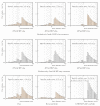Porous Ceramics Adsorbents Based on Glass Fiber-Reinforced Plastics for NOx and SOx Removal
- PMID: 35012186
- PMCID: PMC8747655
- DOI: 10.3390/polym14010164
Porous Ceramics Adsorbents Based on Glass Fiber-Reinforced Plastics for NOx and SOx Removal
Abstract
To reuse waste glass fiber-reinforced plastics (GFRPs), porous ceramics (i.e., GFRP/clay ceramics) were produced by mixing crushed GFRP with clay followed by firing the resulting mixture under different conditions. The possibility of using ceramics fired under a reducing atmosphere as adsorbent materials to remove NOx and SOx from combustion gases of fossil fuels was investigated because of the high porosity, specific surface area, and contents of glass fibers and plastic carbides of the ceramics. NO2 and SO2 adsorption tests were conducted on several types of GFRP/clay ceramic samples, and the gas concentration reduction rates were compared to those of a clay ceramic and a volcanic pumice with high NO2 adsorption. In addition, to clarify the primary factor affecting gas adsorption, adsorption tests were conducted on the glass fibers in the GFRP and GFRP carbides. The reductively fired GFRP/clay ceramics exhibited high adsorption performance for both NO2 and SO2. The primary factor affecting the NO2 adsorption of the ceramics was the plastic carbide content in the clay structure, while that affecting the SO2 adsorption of the ceramics was the glass fiber content.
Keywords: NO2 adsorption performance; SO2 adsorption performance; adsorbent; ceramics; reuse; waste GFRP.
Conflict of interest statement
The authors declare no conflict of interest.
Figures










References
-
- Yang Y., Boom R., Irion B., van Heerden D.-J., Kuiper P., de Wit H. Recycling of Composite Materials. Chem. Eng. Processing: Process Intensif. 2012;51:53–68. doi: 10.1016/j.cep.2011.09.007. - DOI
-
- Nagaoka T. Value-Added Recycling of Disposal Plastics. J. Jpn. Soc. Technol. Plast. 2016;49:175–179. doi: 10.9773/sosei.49.175. - DOI
-
- Yazdanbakhsh A., Bank L.C. A Critical Review of Research on Reuse of Mechanically Recycled FRP Production and End-of-Life Waste for Construction. Polymers. 2014;6:1810–1826. doi: 10.3390/polym6061810. - DOI
-
- Meira Castro A.C.M., Carvalho J.P., Ribeiro M.C.S., Meixedo J.P., Silva F.J.G., Fiúza A., Dinis M.L. An Integrated Recycling Approach for GFRP Pultrusion Wastes: Recycling and Reuse Assessment into New Composite Materials Using Fuzzy Boolean Nets. J. Clean. Prod. 2014;66:420–430. doi: 10.1016/j.jclepro.2013.10.030. - DOI
-
- Denkena B., Dittrich M.-A., Rahner B.-H. Smart and Energy-Efficient Dust Suction Concept for Milling of Fibre-Reinforced Plastics. Prod. Eng. 2017;11:723–729. doi: 10.1007/s11740-017-0776-x. - DOI
LinkOut - more resources
Full Text Sources
Miscellaneous

